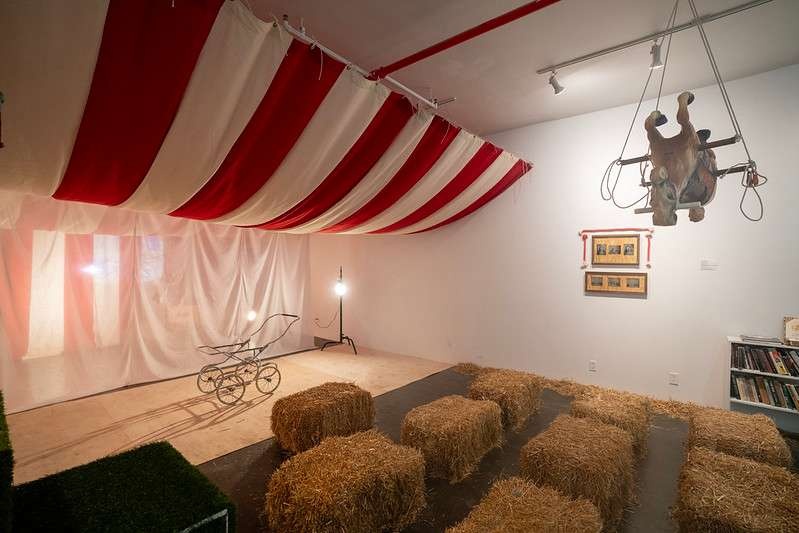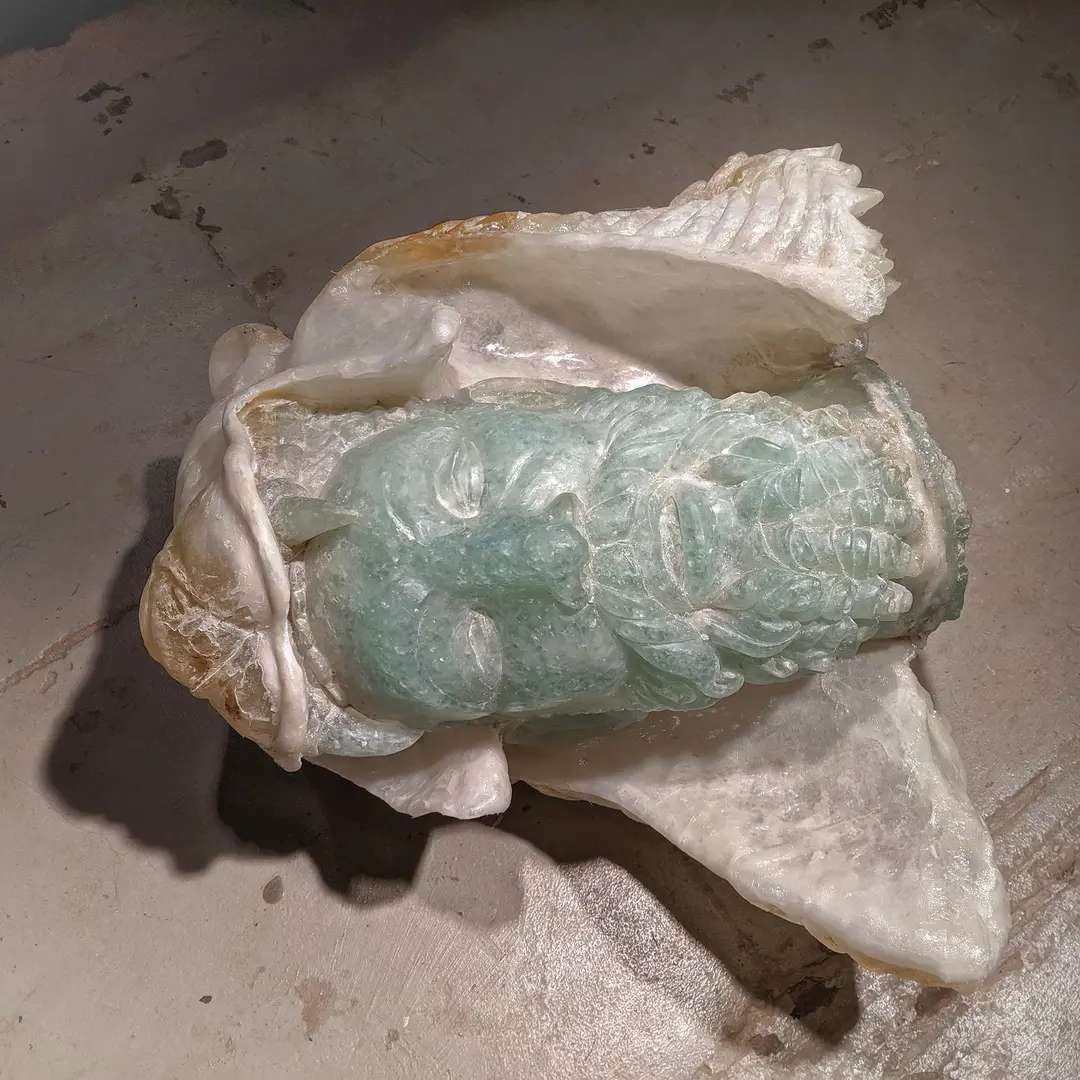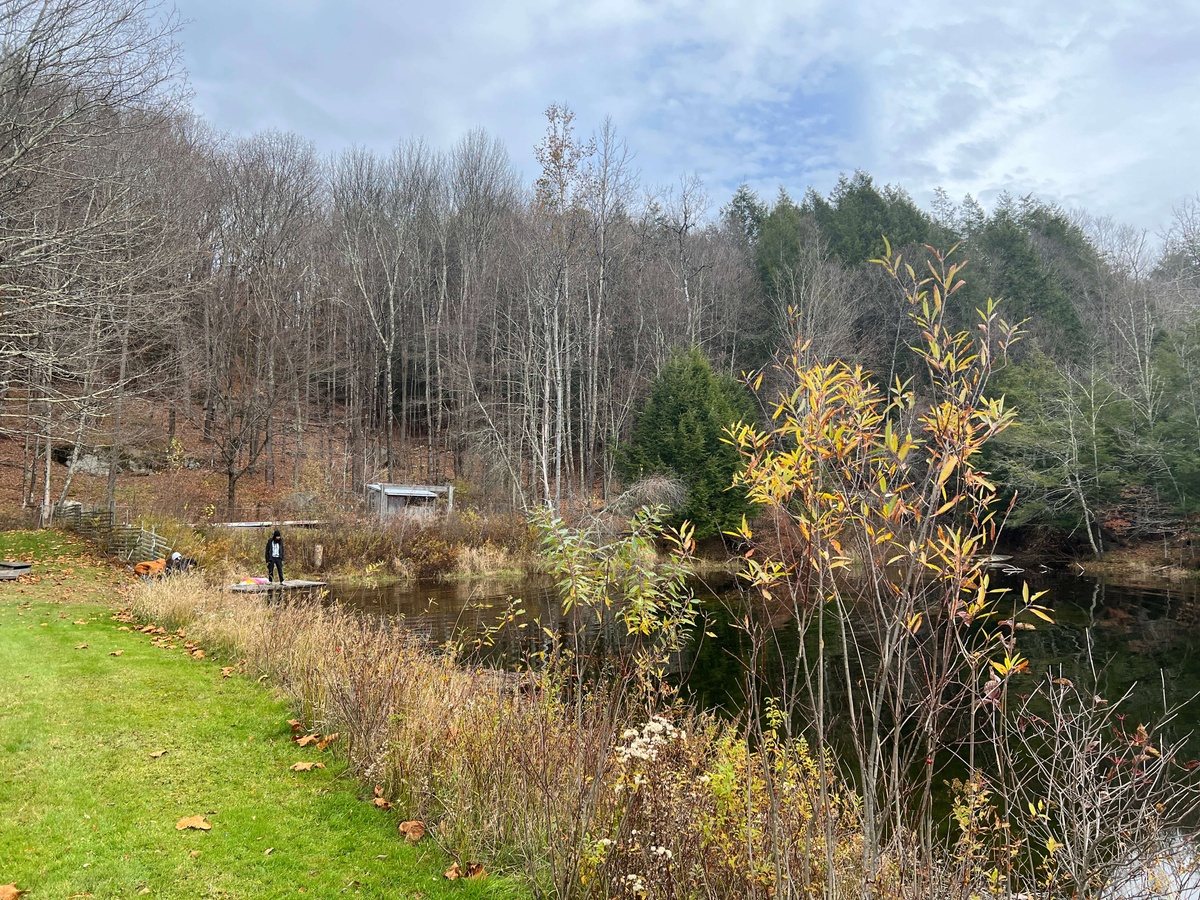Ever Present and in Process: Breathing and Grieving With Ogemdi Ude and Sydney King
Jehan Roberson
I won’t be writing about Covid.
This grief isn’t so much the collective loss we all feel but the ones we don’t. The fervent presence of a particular kind of death doesn’t obscure so much as superimpose the types of death that occur in the everyday. It’s a necessary reckoning to inch nearer and nearer to the process of death, even as it shows up innocuously in our bodies, our conversations, our encounters. But like so many of life’s processes, we don’t come natural to it. For Black and Indigenous folks in particular, death from natural causes is aspirational. We’re far more intimate with the forces of state violence, extractivism, capitalism, and other unnatural ways of dying, particularly in America. It’s an intimacy that’s so common it’s rendered unremarkable.
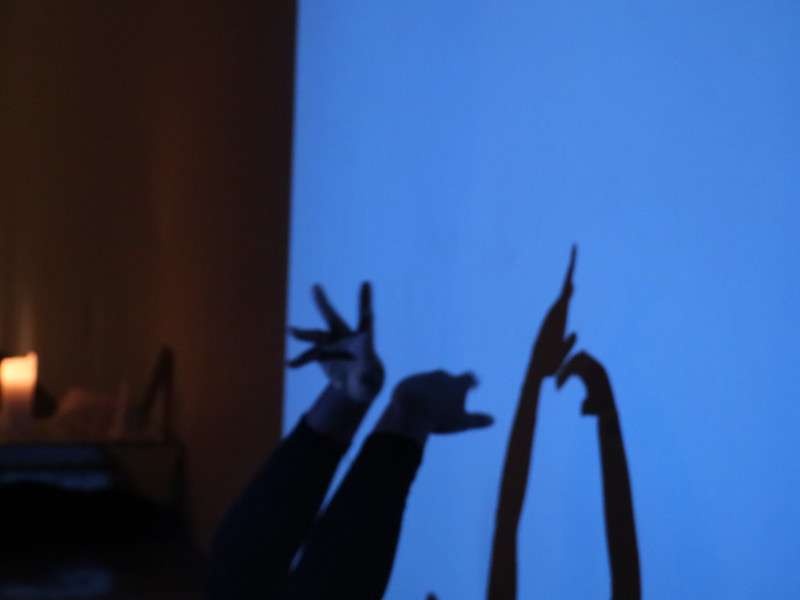

Ogemdi Ude makes shadows with her hands as Sydney King projects light and and captures her movements on film
My great aunt died in May. With her death came a hardening realization that sunk me further into my grief as I contended with its personal enormity and its societal regularity. A Black woman born in the mid-1940s to farmers in West Tennessee, access to healthcare and educational opportunities were what you might expect (lacking to say the least). That she exceeded all expectations to become an incredible physician with many firsts to her name, that she fought every day for Black folks’ right to live—none of those victories undo the everyday violences that led to her cancer and, soon after, her death. It just makes this shit more painful.
All of this is to say, I’ve been thinking a lot about what gets physicalized in the wake of death…breath in particular. This isn’t about Covid, but it is about sobbing behind masks, in isolated corners of quarantine rooms, overcome by fears about when your next touch will come; of gasping, shouting, raging over Zoom vigils and funerals, becoming undone by these incomplete rituals of mourning. It’s not merely the extinguishing of breath that signals one type of death; it’s how we carry the dead with us, alongside our every inhale and exhale.
In Black Pentecostal Breath, Ashon T. Crawley meditates on breath’s proximity to death, particularly in the case of Eric Garner. Crawley writes, “I can’t breathe,’ the announcement of his intensely singular experience, his experience of the ongoing act of racial animus, antiblack racism, violent policing, policing as segregation and the implementation of dispossession and displacement as policy that structures life in the United States. […] ‘I can’t breathe’ as both the announcement of a particular moment and rupture in the life world of the Garners, and ‘I can’t breathe’ as a rupture, a disruption, an ethical plea regarding the ethical crisis that has been the grounds for producing his moment, our time, this modern world (1).” It’s this tension between the “intensely singular experience” and how that experience couples with other singular experiences that comprises the collective. It’s a tension that requires a keen attention to grief and its processes.
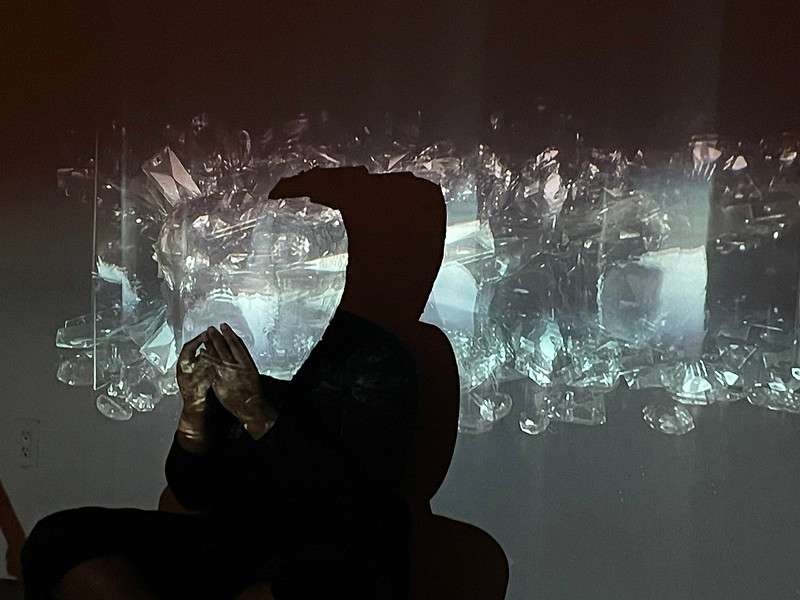

Ogemdi Ude poses with plaster works as Sydney King projects crystal-ditorted light.
Ogemdi Ude and Sydney King approach grief with a tenderness and totality that speaks to their reverence for the many ways in which we die and live. Now, on the other side of 2020, it’s not a matter of if we’ve lost but whom, and how much. In one of our virtual conversations, Sydney spoke of her family members’ internment during WWII, their Japanese heritage receding in exchange for Americanization. She named the ensuing grief as generational, a complicated inheritance of memory and loss. Ogemdi spoke about her own grief over the loss of a lifelong friend as atrophy, an adhesion of muscle, bone and skin, and the act of ‘getting through’ as peeling herself from herself.
Living Relics sits at numerous intersections: death and grief, loss, and commemoration, movement and stillness. Breath animates each aspect of the project—Ogemdi’s movement offering, the commemorative ritual, the plaster casts, the memorial photography. The body’s limits and its porosities are held in delicate balance as Ogemdi and Sydney stage moments of reckoning with grief, their deep understanding of grief’s solitary and collective manifestations.
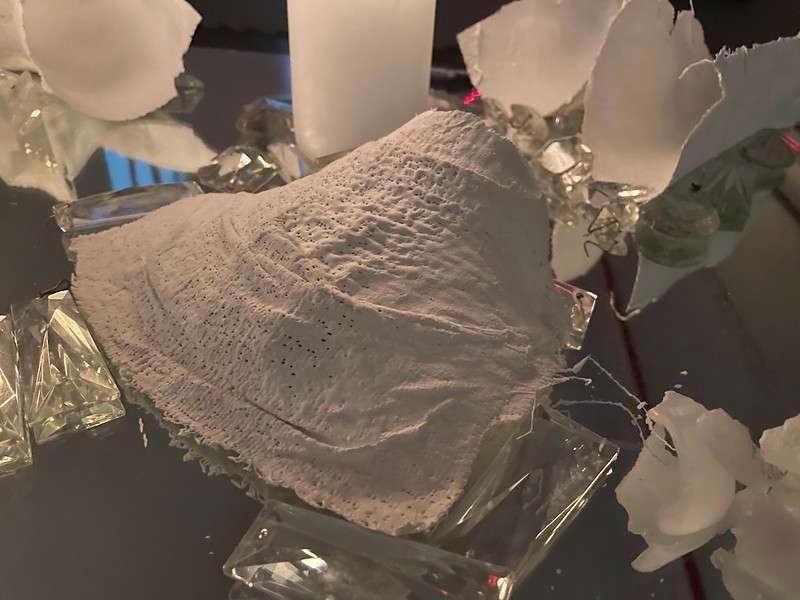

A plaster mold of the neck of one of the Sessions public participants rests atop a glass case, surrounded by candles and shards of crystal.
Within her own process of making the plaster casts, Sydney talks about how the breath is what is able to suspend motion in the stillness required for the practice. Eventually it is the breath that breaks the cast away from the body. What if we were able to mobilize this, embody this dynamic in the everyday, where we allow ourselves to feel it all, to atrophy in those moments of most acute loss while nonetheless allowing our breath to brush up against death, skin to skin or skin to casing—death’s presence feels like a brush against the plaster, rough and often restrictive but nonetheless a reminder of life, of the fragility of movement. There’s intentionality behind each soaked, sticky piece of plaster laid atop another, adhering itself to body and breath.
My own work is in and with (and often against) archives, and I can’t help but think of how Living Relics constructs its own archive. Rather than the sort of historical archival conceit that advances colonial narratives, the archive of Living Relics starts with the realization of that which cannot be held. Ephemera is embodied and thus not entirely tangible. What we can do, though, is capture traces of these moments, these individual griefs, and honor their materialization in the body. In No Archive Will Restore You, Julietta Singh illumines how the body is “ultimately not stable ground upon which to build an archive. […] For better and for worse, we are made up of an outside world which constitutes, nourishes, and poisons us in turns (30).” This type of recognition seems vital for the sort of archive, the sort of register of import that sparks memories and acknowledgements for that which all too often goes unsaid or unacknowledged.
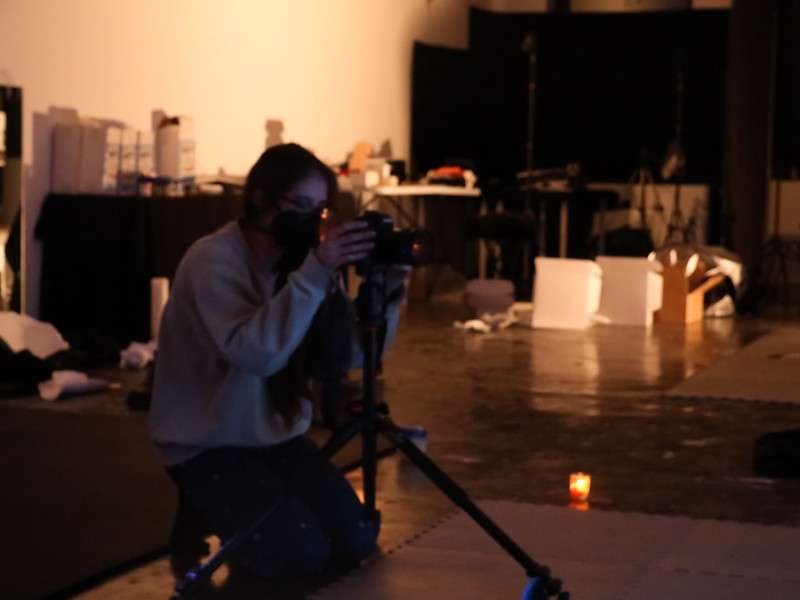

Sydney King and her camera in the Session space.
Whether through embodiment, memory work, sculpture or photography, Living Relics propels us to question where grief houses itself in our bodies and how we might attend to its hand in shaping our everyday lives and rituals. Both Ogemdi and Sydney remind us of the particularities of our individual experiences of death and grief as a way of seeing how, like breath, they exceed the individual, and how, like breath, they merge to collectively sustain us from one moment to the next.
About the artist
Jehan Roberson
Jehan Roberson is a queer writer, scholar, artist, and memory worker using text as the basis for her interdisciplinary practice. Born and raised in Memphis, TN, Jehan’s work explores text as a site of liberation, place making, and historical intervention for Black peoples in the Americas. Her art and research have informed her previous work in archives and cultural sites such as the National Civil Rights Museum and the Center for Southern Folklore in Memphis, Kismet Productions in Chicago, and the Borges Cultural Center in Buenos Aires, Argentina. Jehan is a PhD student in English Language and Literatures at Cornell University. She holds a MA from NYU’s John W. Draper School of Humanities and Social Thought and a BA in English Literature with a double minor in Spanish and Journalism from the University of Missouri.
Explore/Archive
See allJuly 2025
Tell My Jockey: CUNTRY’s Discourse From the Horse’s Mouth
Ericka Pérez
Assembly fellow Ericka Pérez reflects on clowning, resistance, and CUNTRY’s radical refusal to perform.
April 2025
The Second Head of Hercules: Art and Resistance Through Four Years of Upheaval
Shakeem Floyd
written in conjunction with artist Onyedike Chuke's Session x Assembly project, The Forever Museum Archive: Circa 2020_An Object
April 2025
Shakeem Floyd
written in conjunction with artist Marcela Torres' Session x Assembly project, The flow of mud/barro.
